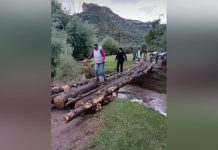Africa-Press – Lesotho. For many decades now, the entire world has been debating on means and measures to adopt so as not to have to face up a situation of inadequate availability of water in different parts of the world.
It is a serious issue as, in certain cases, it can even lead to “water wars” between neighbouring countries given the importance of this precious liquid to the very sustenance of life.
Unfavourable climatic conditions, being increasingly exacerbated by global warming, galloping demography, growing demand for an adequate supply of water in the industrial and agricultural sectors are among the reasons why water is predicted to become even more scarce in the years to come.
In the local context, the Midlands Dam and the Bagatelle Dam, both inaugurated after years of work and which have added to the capacity of our reserves, have unfortunately not been commensurate with the growing demand for water due to population growth, water-intensive industrial activities, tourism and an increasing number of expats now living in the country.
There is also the issue of leaking pipes all over the island as well as those pipes which transport water from the high-gravity parts of the island to the lower regions requiring urgent replacement and modernisation — all of which require investments to the tune of billions of rupees; others have been battered by works carried out by other departments and left to leak out.
In other words, we have not deployed the necessary resources to even prevent whatever little water we have been able to store and distribute to good purpose. Needless to add that when the rains really drop down, we see a lot of flooding and loss of precious surface water that could have been harnessed.
Engineers, economists and financial managers with experience in this sector are of the view that there are three factors at least at the basis of this fundamental failure to tap and retain an essential and basic element for our day-to-day needs.
One is said to be the failure of those in positions to take strategic decisions with the objective of obtaining an enduring solution. This work should have been the responsibility of the Ministry in charge, and perhaps the Water Resources Unit of that Ministry.
Progress could and should have been made along several avenues: the river dam at Riviere des Anguilles has been on the cards and even budgeted sometimes, to no avail, several delocalised dams with containerised filtration units and obligation for luxury IRS schemes to have their own desalination plants could all have been planned through.
The second factor relates to the financial resources made available to develop this essential infrastructure. It costs money to build new dams and reservoirs, replace leaking pipes or lay down new ones.
This is also said not to have kept pace with the growing demand for water. Most of all, and this is where it hurts the viability of public service institutions is the reluctance of politicians in power to address the financial feasibility of these institutions.
One may argue that water is a public good and must be kept exclusively as such, in terms of both collection and supply, and that the State that should bear the major part of costs, but it takes billions to ensure storage and supply (24/7?) all over the island; it also takes courage to charge consumers more for their daily water supplies to raise enough funds to meet capital expenditures.
For More News And Analysis About Lesotho Follow Africa-Press






